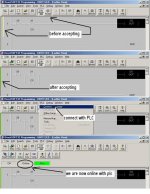peoplehouse
Member
Hello group, at work we predominately use PLC5's so the only software that I've worked with is logix5. We have a bunch of stand alone Automation Direct DL105's in our shipping fluid loaders. I discovered that we have the software! (Directsoft32)
I decided to create a project and learn a new language. I'm just a maint. dude but managed to figure that X and Y are discrete I/O and C = coil. (C being a bit of a word?) Here is where I get discouraged, V MEMORY LOCATION.
My problem is that I compare everything to Rockwell stuff. So is V memory kind of like an integer or binary word? AHHHH sorry folks, now I'm lost.
Anyways I've Googled, You tubed, searched archives here but the user manual doesn't quite explain what I need to know. I'm sorry that I am not more specific, just trying to understand something else than I:012/00 or N7:2/1
Thanks all
Jeff
I decided to create a project and learn a new language. I'm just a maint. dude but managed to figure that X and Y are discrete I/O and C = coil. (C being a bit of a word?) Here is where I get discouraged, V MEMORY LOCATION.
My problem is that I compare everything to Rockwell stuff. So is V memory kind of like an integer or binary word? AHHHH sorry folks, now I'm lost.
Anyways I've Googled, You tubed, searched archives here but the user manual doesn't quite explain what I need to know. I'm sorry that I am not more specific, just trying to understand something else than I:012/00 or N7:2/1
Thanks all
Jeff





